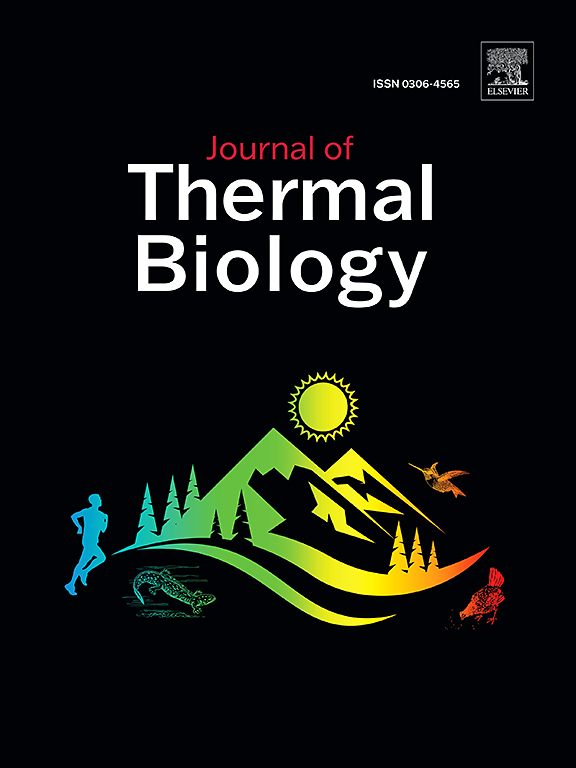地中海鸣禽耐热性和冷却效率的季节性和种群间差异
IF 2.9
2区 生物学
Q2 BIOLOGY
引用次数: 0
摘要
分布广泛的物种的离散种群可能栖息在不同地理和季节范围内气候条件差异明显的地区,这可能导致种内热生理学差异,反映出遗传适应、表型可塑性或两者兼而有之。然而,很少有研究评估种群间对热的生理反应的差异。我们评估了两个热环境截然不同的地中海大山雀种群在耐热性、冷却效率和其他主要体温调节特征方面的种群内和种群间季节性差异:低地种群的夏季更热,年热振幅比山地种群更大。具体来说,我们测量了冬季和夏季热中性区内和热中性区以上的耐热极限(HTL)、体温、静息代谢率、蒸发失水和蒸发冷却效率(蒸发失热与代谢产热的比率)。与山地鸟类相比,低地鸟类在夏季的耐热能力更强;事实上,低地鸟类的这一特性会季节性地显著增强,而山地鸟类的这一特性则较弱。此外,低地鸟类在夏季表现出更高的蒸发冷却效率(部分原因可能是内源热负荷总量的减少),而山地鸟类却表现出令人惊讶的相反趋势。因此,低地鸟类的体温蒸发潜能值、体温和静止代谢率的季节灵活性高于恒温性,从而在一定程度上支持了气候变异假说--体温调节特征的灵活性应随气候变异而增加。我们的研究结果部分支持了鸣禽在高温下的适应性体温调节是灵活的这一观点,突出了在模拟不同气候变化情景下物种的未来分布和持续性时考虑体温调节特征的种内变异的重要性。本文章由计算机程序翻译,如有差异,请以英文原文为准。
Seasonal and between-population variation in heat tolerance and cooling efficiency in a Mediterranean songbird
Discrete populations of widely distributed species may inhabit areas with marked differences in climatic conditions across geographic and seasonal scales, which could result in intraspecific variation in thermal physiology reflecting genetic adaptation, phenotypic plasticity, or both. However, few studies have evaluated inter-population variation in physiological responses to heat. We evaluated within- and inter-population seasonal variation in heat tolerance, cooling efficiency and other key thermoregulatory traits in two Mediterranean populations of Great tit Parus major experiencing contrasting thermal environments: a lowland population subject to hotter summers and a higher annual thermal amplitude than a montane population. Specifically, we measured heat tolerance limits (HTL), body temperature, resting metabolic rate, evaporative water loss, and evaporative cooling efficiency (the ratio between evaporative heat loss to metabolic heat production) within and above the thermoneutral zone during winter and summer. Heat tolerance during summer was greater in lowland than in montane birds; indeed, lowland birds seasonally increased this trait to a significant level, while montane ones did to a lesser extent. Besides, lowland birds showed greater evaporative cooling efficiency during summer (possibly due in part to reductions in total endogenous heat load), while surprisingly montane ones showed the opposite trend. Thus, lowland birds displayed greater seasonal flexibility in HTL, body temperature and resting metabolic rate above thermoneutrality, thus giving some support to the climatic variability hypothesis — that flexibility in thermoregulatory traits should increase with climatic variability. Our results partially support the idea that songbirds’ adaptive thermoregulation in the heat is flexible, highlighting the importance of considering intraspecific variation in thermoregulatory traits when modelling the future distribution and persistence of species under different climate change scenarios.
求助全文
通过发布文献求助,成功后即可免费获取论文全文。
去求助
来源期刊

Journal of thermal biology
生物-动物学
CiteScore
5.30
自引率
7.40%
发文量
196
审稿时长
14.5 weeks
期刊介绍:
The Journal of Thermal Biology publishes articles that advance our knowledge on the ways and mechanisms through which temperature affects man and animals. This includes studies of their responses to these effects and on the ecological consequences. Directly relevant to this theme are:
• The mechanisms of thermal limitation, heat and cold injury, and the resistance of organisms to extremes of temperature
• The mechanisms involved in acclimation, acclimatization and evolutionary adaptation to temperature
• Mechanisms underlying the patterns of hibernation, torpor, dormancy, aestivation and diapause
• Effects of temperature on reproduction and development, growth, ageing and life-span
• Studies on modelling heat transfer between organisms and their environment
• The contributions of temperature to effects of climate change on animal species and man
• Studies of conservation biology and physiology related to temperature
• Behavioural and physiological regulation of body temperature including its pathophysiology and fever
• Medical applications of hypo- and hyperthermia
Article types:
• Original articles
• Review articles
 求助内容:
求助内容: 应助结果提醒方式:
应助结果提醒方式:


